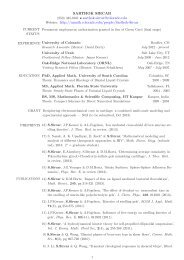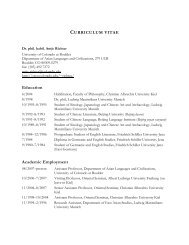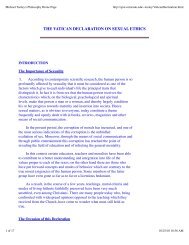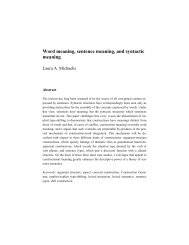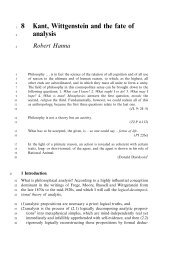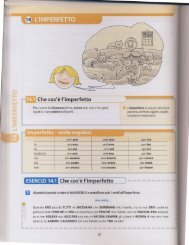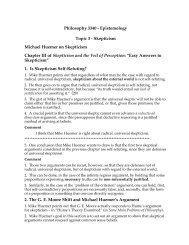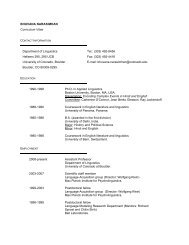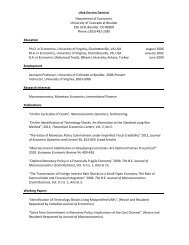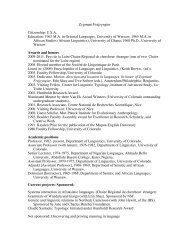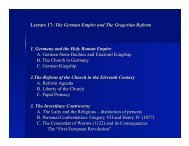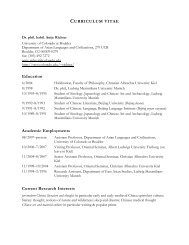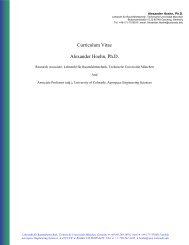Battling Tengu, Battling Conceit - Colorado - University of Colorado ...
Battling Tengu, Battling Conceit - Colorado - University of Colorado ...
Battling Tengu, Battling Conceit - Colorado - University of Colorado ...
Create successful ePaper yourself
Turn your PDF publications into a flip-book with our unique Google optimized e-Paper software.
Japanese Journal <strong>of</strong> Religious Studies 39/2: 275–305<br />
© 2012 Nanzan Institute for Religion and Culture<br />
R. Keller Kimbrough<br />
<strong>Battling</strong> <strong>Tengu</strong>, <strong>Battling</strong> <strong>Conceit</strong><br />
Visualizing Abstraction in The Tale <strong>of</strong> the Handcart Priest<br />
The sixteenth- or early seventeenth-century Tale <strong>of</strong> the Handcart Priest tells <strong>of</strong><br />
an eccentric Zen practitioner’s encounter with the legendary Tarōbō, a tengu <strong>of</strong><br />
Mt. Atago who is attracted to the priest because <strong>of</strong> the priest’s excessive pride.<br />
This article provides a close reading <strong>of</strong> The Tale <strong>of</strong> the Handcart Priest in its historical<br />
and literary context, drawing upon such related works as the noh plays<br />
Kuruma-zō and Zegai, the otogizōshi Matsuhime monogatari and Itozakura no<br />
monogatari, and the puppet play Shuten Dōji wakazakari. I discuss the significance<br />
<strong>of</strong> tengu, carts, and handcart priests in Japanese textual and pictorial<br />
sources from the twelfth through eighteenth centuries, as well as the possibilities<br />
for psychological realism in the larger world <strong>of</strong> medieval Japanese fiction.<br />
Taking a psychoanalytic interpretive approach, I argue that in Kuruma-zō<br />
sōshi and other medieval and Edo-period literary sources, characters’ struggles<br />
with tengu can <strong>of</strong>ten be read allegorically as externalized depictions <strong>of</strong> those<br />
characters’ internal struggles with their own “demons” <strong>of</strong> conceit.<br />
keywords: tengu—Zen—otogizōshi—nara ehon—setsuwa—noh—Tarōbō—<br />
Zegaibō—medieval Buddhist fiction<br />
R. Keller Kimbrough is an associate pr<strong>of</strong>essor <strong>of</strong> Japanese Literature at the <strong>University</strong> <strong>of</strong><br />
<strong>Colorado</strong> Boulder.<br />
275
figure 7. Tarōbō convenes a conference <strong>of</strong> tengu. From Kuruma-zō sōshi,<br />
ca. seventeenth century. Courtesy <strong>of</strong> the Kyoto <strong>University</strong> Library.
figure 8. Zegaibō visits Tarōbō on Mt. Atago. From a<br />
nara ehon edition <strong>of</strong> the noh play Zegai, ca. seventeenth<br />
century. Private collection, courtesy <strong>of</strong> Takahashi Tōru.<br />
figure 9. Zegaibō (bottom right) introduces Akudōmaru (middle) to Maheśvara<br />
(top left). From Shuten Dōji wakazakari, 1660. Courtesy <strong>of</strong> the National Diet Library.
kimbrough: the tale <strong>of</strong> the handcart priest | 295<br />
equanimity—for a while, at least—in the face <strong>of</strong> Tarōbō and the other tengu’s<br />
ranting provocation. As always, the contest between the tengu and the priest<br />
revolves around the cart:<br />
The Handcart Priest gazed up toward Mount Atago, where he saw a black<br />
cloud trailing in the sky. It contained Tarōbō and a multitude <strong>of</strong> other tengu,<br />
too numerous to count. The priest had been expecting them, however, and he<br />
was not disturbed in the least. “You can’t move my heart,” he said, “no matter<br />
how you try. So just go home.”<br />
The tengu replied: “Say what you like, but we can take you if we want!” They<br />
all jumped down on the snow and began to lash the priest’s cart with switches.<br />
The priest watched and then exclaimed: “What an amazing bunch <strong>of</strong> creatures!<br />
Do you think the cart will move if you thrash it? Why don’t you whip the ox<br />
instead?”<br />
“True” the tengu said, “the cart has no mind.” They wished to strike the ox,<br />
but there was none to strike. “Just beat the cart,” they cried, the same as before.<br />
They flogged it mercilessly, but the cart refused to budge. The priest watched.<br />
“Stupid fools on the path <strong>of</strong> man and ox!” he said. “Why don’t you strike the ox<br />
that you can see? Or are you blind to the man-ox before your eyes? Get away<br />
from there!”<br />
The tengu were enraged. “So if we beat you,” they said, “then the cart will<br />
move?” “Of course!” the priest replied. “Now I’ll show you how I strike the<br />
white ox <strong>of</strong> the open space. Watch this!” The Handcart Priest raised his hossu<br />
flapper and struck the air. Strange to say, the cart, which until now had seemed<br />
to be a rickety contraption, wobbled forward with neither an ox nor a man to<br />
pull and instantly flew up into the sky. It circled around the mountains and rivers<br />
<strong>of</strong> Saga, Ogura, Ōi, and Arashi before returning. The tengu were stunned as<br />
they took in the sight.<br />
The Handcart Priest refers to the “white ox <strong>of</strong> the open space,” alluding to the<br />
Lotus Sutra parable <strong>of</strong> the burning house. He implicitly equates his own humble<br />
cart with the Single Vehicle <strong>of</strong> the Dharma, represented in the parable by<br />
the marvelous jeweled carriages that the father presents to each <strong>of</strong> his sons. 33<br />
The association is an immodest one, but it is not without effect. By invoking<br />
the power <strong>of</strong> the Single Vehicle, the Handcart Priest literally transcends his<br />
tengu opponents, demonstrating the primacy <strong>of</strong> the Buddhist Law. An illustration<br />
shows the Handcart Priest and his cart soaring on a cloud in the sky, while<br />
Tarōbō and another tengu watch from below (figure 10, following page).<br />
33. The Lotus Sutra explains that the carriages were “tall and spacious and adorned with<br />
numerous jewels,” and that “each carriage was drawn by a white ox, pure and clean in hide,<br />
handsome in form and <strong>of</strong> great strength, capable <strong>of</strong> pulling the carriage smoothly and properly<br />
at a pace fast as the wind” (t 9 [262]: 12c, lines 19 and 22–23; Watson 1993, 57–58). Translation<br />
here by Watson.
298 | Japanese Journal <strong>of</strong> Religious Studies 39/2 (2012)<br />
figure 12. The tengu sit with<br />
the Handcart Priest. From<br />
Kuruma-zō sōshi, ca. seventeenth<br />
century. Courtesy <strong>of</strong> the<br />
Kyoto <strong>University</strong> Library.<br />
pray for her salvation, and it is this that stirs him to take Buddhist vows and eventually<br />
become a handcart priest (mjmt supp. 1: 241b–42a). Although it is tempting<br />
to imagine that Tarōbō chooses to reveal the ashura realm in Kuruma-zō sōshi<br />
because he knows <strong>of</strong> the Handcart Priest’s former trauma (if we take the handcart<br />
priests <strong>of</strong> Kuruma-zō sōshi and Matsuhime monogatari to be the same), there is in<br />
fact no allusion in Kuruma-zō sōshi to a former wife or to any kind <strong>of</strong> grief, suggesting<br />
that the presence <strong>of</strong> the ashura realm in the two works is merely coincidental.<br />
Whatever Tarōbō’s motivations may have been in conjuring the violent vision,<br />
his magical mischief can be seen to take a toll:<br />
The Handcart Priest thought to himself, “This is amazing, fascinating!” His<br />
mind was slightly shaken. The tengu realized that they were succeeding. “Listen,<br />
priest,” they said, “we can show you sights like these for a hundred days<br />
and a hundred nights, if we choose.”<br />
The Handcart Priest quickly regained his composure. “Once will be<br />
enough,” he said. “From now on, I’ll use my Buddhist powers to keep you from<br />
performing such feats.”<br />
“But they’re easy to do!” the tengu shot back. “Shall we show you a vision <strong>of</strong><br />
the Paradise World this time? 36 Here, take a look!”<br />
36. The Pure Land Paradise <strong>of</strong> Amida Buddha.



